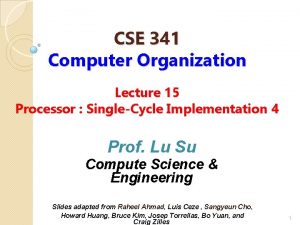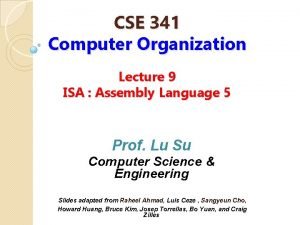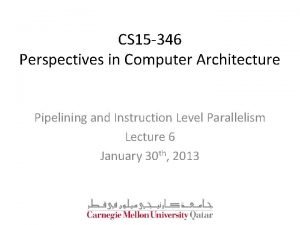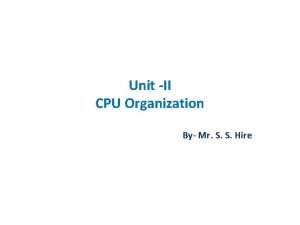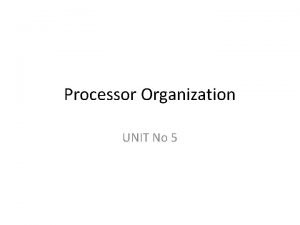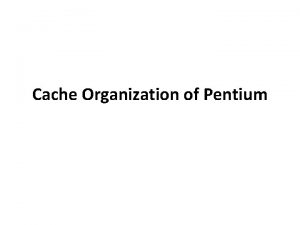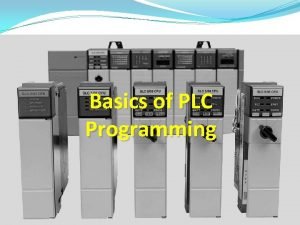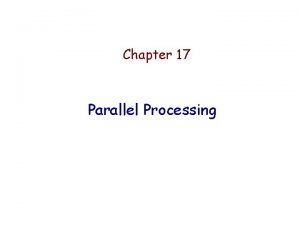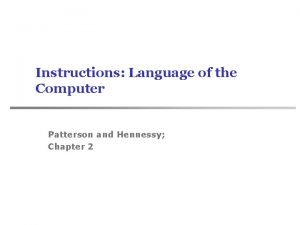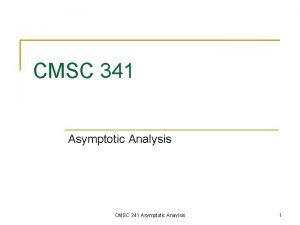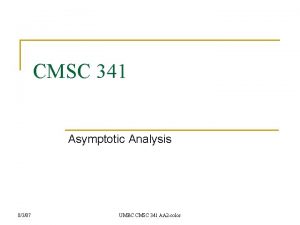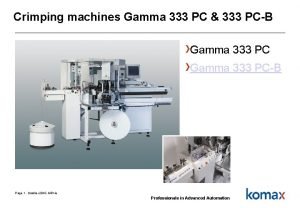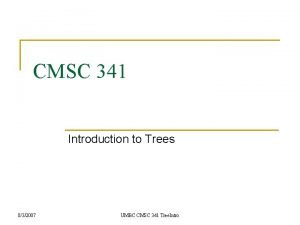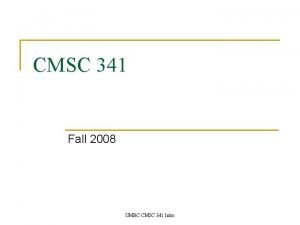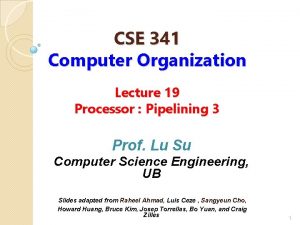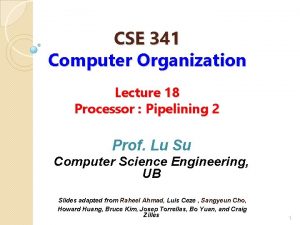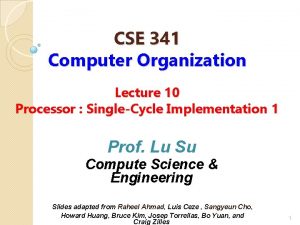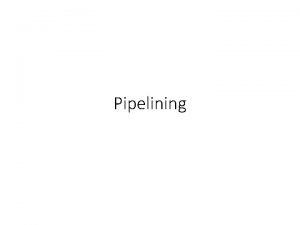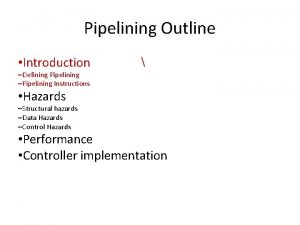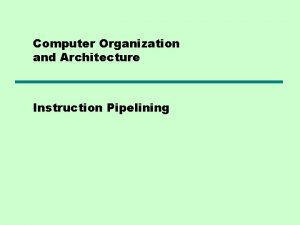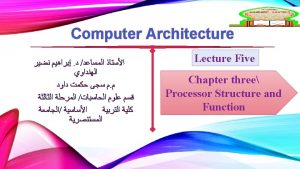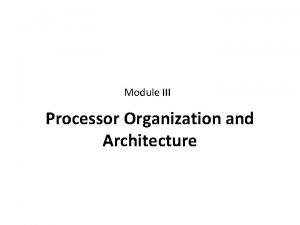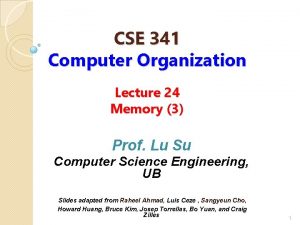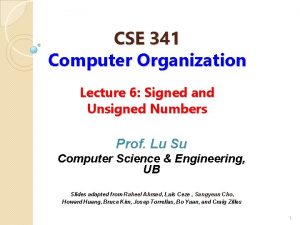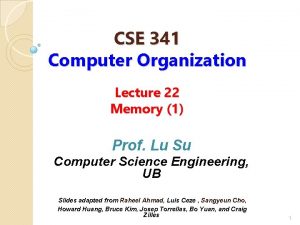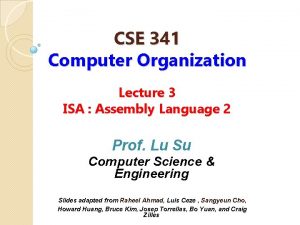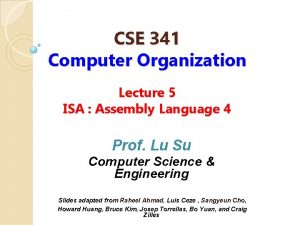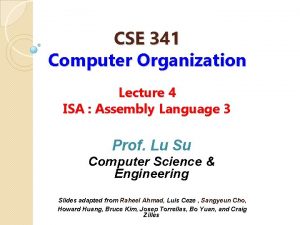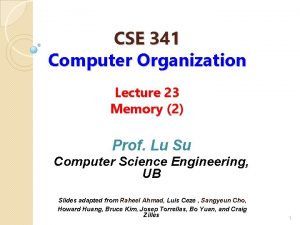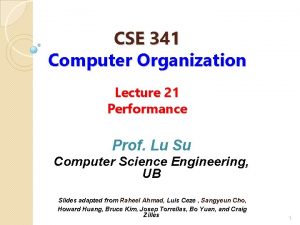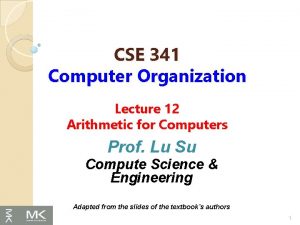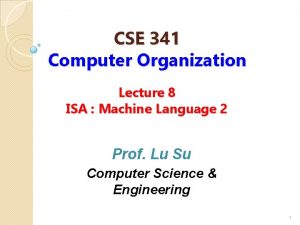CSE 341 Computer Organization Lecture 20 Processor Pipelining
























- Slides: 24

CSE 341 Computer Organization Lecture 20 Processor : Pipelining 4 Prof. Lu Su Computer Science Engineering, UB Slides adapted from Raheel Ahmad, Luis Ceze , Sangyeun Cho, Howard Huang, Bruce Kim, Josep Torrellas, Bo Yuan, and Craig Zilles 1

Task III l Single-cycle implementation: -- All operations takes in one clock cycle l Multi-cycle implementation: -- Fast operations take less time than slower ones l Pipelining -- Overlap the execution of several instructions 2

Example with dependencies sub and or add sw l Several $2, $1, $3 $12, $5 $13, $6, $2 $14, $2 $15, 100($2) dependencies in this code fragment. -- The first instruction, SUB, stores a value into $2. -- $2 is used as a source in the rest of the instructions. l Not a problem for the single/multi cycle datapaths. 3 -- Each instruction is executed completely

Dependency Arrows Clock cycle 1 2 3 sub $2, $1, $3 IM Reg and $12, $5 IM or $13, $6, $2 add $14, $2 sw $15, 100($2) 4 DM Reg IM 5 7 8 Reg DM Reg IM 6 Reg DM Reg IM Reg DM Reg 4

Review of Forwarding l Forwarding allows other instructions to read ALU results directly from the pipeline registers, without going through the register file. 1 Clock cycle 3 4 2 IM sub $2, $1, $3 and $12, $5 or $13, $6, $2 Reg IM DM Reg IM 5 7 Reg DM Reg 6 Reg DM Reg 5

Limitation of Pipelining Some real limitations of pipelining. -- Forwarding may not work for data hazards from load instructions. -- Branches affect the instruction fetch for the next clock cycle. l In both of these cases, we may need to slow down, or stall, the pipeline. l 6

An Example for load For the following example -- The load data doesn’t come from memory until the end of cycle 4. -- But the AND needs that value at the beginning of the same cycle! l This is a “true” data hazard—the data is not available when we need it. l 1 2 IM lw $2, 20($3) and $12, $5 Clock cycle 3 Reg IM DM Reg 4 5 6 Reg DM Reg 7

Stalling The easiest solution is to stall the pipeline. l We could delay the AND instruction by introducing a one-cycle delay into the pipeline, sometimes called a bubble. l Notice that we’re still using forwarding in cycle 5, to get data from the MEM/WB pipeline register to the ALU. l 1 2 IM lw $2, 20($3) and $12, $5 Clock cycle 3 4 Reg IM DM Reg 5 6 Reg DM Reg 8

Stalling and Forwarding Without forwarding, we’d have to stall for two cycles to wait for the LW instruction’s writeback stage. l In general, you can always stall to avoid hazards— but dependencies are very common in real code, and stalling often can reduce performance by a significant amount. Clock cycle l 1 2 IM lw $2, 20($3) and $12, $5 3 Reg IM 4 DM 5 6 7 Reg DM Reg 9

Stalling Delays the Entire Pipeline l If we delay the second instruction, we’ll have to delay the third one too. -- To make forwarding work between AND and OR. -- Also prevents problems such as two instructions trying to write to the same register in the same Clock cycle. 1 2 IM lw $2, 20($3) and $12, $5 or $13, $12, $2 3 Reg IM 4 DM 5 7 Reg IM 6 DM Reg 10

Implementing Stalls One way to implement a stall is to force the two instructions after LW to pause and remain in their ID and IF stages for one extra cycle. l This is easily accomplished via: -- Don’t update PC, so current IF stage is repeated. -- Don’t update IF/ID register, so ID stage is repeated. l 11

Implement Stalling for EXE, MEM, WB l Those units aren’t used in those cycles because of the stall, so the control signals of EX, MEM and WB can be set to all 0 s. 12

Stall = Nop conversion � In fact, the effect of a load stall is to insert an empty or nop instruction into the pipeline 1 lw $2, 20($3) and -> nop and or 2 IM $12, $5 $13, $12, $2 3 Reg IM Clock cycle 4 DM Reg IM 6 7 Reg DM Reg IM 5 Reg DM Reg 13

Stall Control Stall is needed when load hazard happens. l We can detect a load hazard between the current instruction in its ID stage and the previous instruction in the EX stage. l A hazard occurs if the previous instruction was LW. . . ID/EX. Mem. Read = 1 l . . . and the LW destination is one of the current source registers. ID/EX. Register. Rt = IF/ID. Register. Rs or ID/EX. Register. Rt = IF/ID. Register. Rt l Complete test for stalling: if (ID/EX. Mem. Read = 1 and (ID/EX. Register. Rt = IF/ID. Register. Rs or ID/EX. Register. Rt = IF/ID. Register. Rt))14

Unified Hazard Detection Unit l The hazard detection unit’s inputs are as follows. -- IF/ID. Register. Rs and IF/ID. Register. Rt, the source registers for the current instruction. -- ID/EX. Mem. Read and ID/EX. Register. Rt, to determine if the previous instruction is LW and, if so, which register it will write to. l By inspecting these values, the detection unit generates three outputs. -- Two new control signals PCWrite and IF/ID Write, which determine whether the pipeline stalls or continues. -- A mux select for a new multiplexer, which forces control signals for the current EX and future MEM/WB stages to 0 in case of a stall. 15

PC Write IF/ID Write Datapath with Unified Hazard Unit ID/EX. Mem. Read Hazard Unit Rs ID/EX Rt 0 0 1 Control PC WB EX/MEM M WB MEM/WB EX M WB IF/ID Read register 1 data 1 Addr ID/EX. Register. Rt Instr Read register 2 Write register Instruction memory Write data Read data 2 Registers 0 1 2 ALU Zero ALUSrc 0 1 2 Result 0 Address Data memory 1 Instr [15 - 0] Reg. Dst Extend Rt Write Read data 0 0 Rd 1 Rs 1 EX/MEM. Register. Rd Forwarding Unit MEM/WB. Register. Rd 16

Control Hazard in Branch Most of work for a branch computation is done in EX stage. -- The branch target address is computed. -- The source registers are compared by the ALU, and the Zero flag is set or cleared accordingly. l The branch decision cannot be made until end of EX stage. -- But we need to know which instruction to fetch next, in order to keep the pipeline running. Clock cycle 1 7 -- This leads to 2 what’s 3 called a 4 control 5 hazard. 6 l beq ? ? ? $2, $3, Label. IM Reg DM Reg IM 17

Stalling for Control Hazard Stalling is one possible solution for control hazard. -- In the following example we just stall until cycle 4, after we do make the branch decision. l 1 beq ? ? ? $2, $3, Label. IM 2 3 Clock cycle 4 Reg DM Reg IM IM Reg 5 6 7 DM Reg 18

Branch Prediction is another approach! -- To guess whether or not the branch is taken. -- Usually it’s easier to assume the branch is not taken. -- In this case we just increment the PC and continue execution, as for normal instructions. � If we’re correct, then there is no problem and the pipeline keeps going at full speed. l 19

Branch Misprediction � If our guess is wrong, then we would have already started executing two instructions incorrectly. We’ll have to discard, or flush, those instructions and begin executing the right ones from the labeled Clock cycle instructions. 1 2 3 4 5 6 7 beq $2, $3, Label IM next instruction 1 next instruction 2 Reg IM DM Reg flush IM Label: . . . Reg DM Reg 20

l Gains and Losses for Brach Prediction Overall, branch prediction is worth it. -- Mispredicting means that two clock cycles are wasted. -- But if our predictions are even just occasionally correct, then this is preferable to stalling and wasting two cycles for every branch. l All modern CPUs use branch prediction. -- Accurate predictions are important for optimal performance. -- Most CPUs predict branches dynamically—statistics are kept at run-time to determine likelihood of a branch being taken. l Pipeline structure also has big impact on branch prediction. -- Longer pipeline may require more instructions to be 21

Dynamic Branch Prediction 1 -bit Predictor �Branch prediction buffer: a small memory indexed by the lower portion of the address of the branch instruction. �The memory contains a bit that says whether the branch was recently taken or not. T Predict Taken NT 1 NT T 0 Predict not taken 22

Dynamic Branch Prediction 2 -bit Predictor �In a 2 -bit scheme, a prediction must be wrong twice before it is changed. 23

Summary Three kinds of hazards when pipelining. l Structural hazards result from not having enough hardware available to execute multiple instructions simultaneously. -- Solution: adding more functional units or by redesigning the pipeline stages. l Data hazards can occur when instructions need to access registers that haven’t been updated yet. -- Solution: Forwarding for R-type instructions -- Stalling for Loads instructions l Control hazards arise when the CPU cannot determine which instruction to fetch next. -- Solution: Minimize delays by doing branch tests earlier in the pipeline. 24
 Jump instruction
Jump instruction Cse 341
Cse 341 Organisasi sistem komputer
Organisasi sistem komputer Linear and non linear pipelining in computer architecture
Linear and non linear pipelining in computer architecture Instruction pipelining in computer architecture
Instruction pipelining in computer architecture Process organization in computer organization
Process organization in computer organization 01:640:244 lecture notes - lecture 15: plat, idah, farad
01:640:244 lecture notes - lecture 15: plat, idah, farad Processor organization
Processor organization Data flow, fetch cycle
Data flow, fetch cycle Explain cache organization of pentium processor
Explain cache organization of pentium processor The memory organization of a plc is often called
The memory organization of a plc is often called Processor organization
Processor organization Tos example for elementary
Tos example for elementary Basic structure of computer system
Basic structure of computer system Difference between architecture and organization
Difference between architecture and organization Basic computer organization and design
Basic computer organization and design Design of basic computer with flowchart
Design of basic computer with flowchart Sda hymn 341
Sda hymn 341 Ecma-341
Ecma-341 Cmsc 341
Cmsc 341 Umbc cmsc 341
Umbc cmsc 341 Round 271 to the nearest hundred
Round 271 to the nearest hundred Komax 331
Komax 331 Cmsc 341
Cmsc 341 Umbc cmsc 341
Umbc cmsc 341
